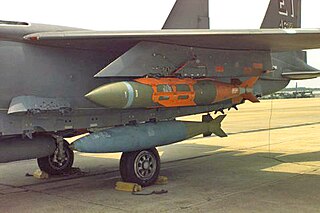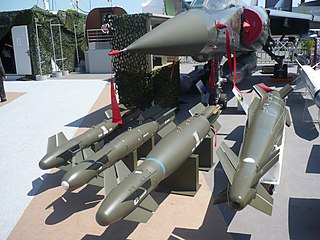
The Rockwell B-1 Lancer is a supersonic variable-sweep wing, heavy bomber used by the United States Air Force. It has been nicknamed the "Bone". It is one of the Air Force's three strategic bombers, along with the B-2 Spirit and the B-52 Stratofortress, as of 2024. Its 75,000-pound payload is the heaviest of any U.S. bomber.
The GBU-10 Paveway II is an American Paveway-series laser-guided bomb, based on the Mk 84 general-purpose bomb, but with laser seeking capabilities and wings for guidance. Introduced into service c. 1976, it is used today by the USAF, US Navy, US Marine Corps, Royal Australian Air Force and various NATO air forces.
The GBU-28 is a 4,000-pound (1814.3 kg) class laser-guided "bunker busting" bomb produced originally by the Watervliet Arsenal, Watervliet, New York. It was designed, manufactured, and deployed in less than three weeks due to an urgent need during Operation Desert Storm to penetrate hardened Iraqi command centers located deep underground. Only two of the weapons were dropped in Desert Storm, both by F-111Fs. One GBU-28 was dropped during Operation Iraqi Freedom. It was designed by Albert L. Weimorts.

The Mark 83 is a 1,000-pound (450 kg) bomb, part of the Mark 80 series of low-drag general-purpose bombs in United States service.
The Joint Direct Attack Munition (JDAM) is a guidance kit that converts unguided bombs, or "dumb bombs", into all-weather precision-guided munitions (PGMs). JDAM-equipped bombs are guided by an integrated inertial guidance system coupled to a Global Positioning System (GPS) receiver, giving them a published range of up to 15 nautical miles (28 km). JDAM-equipped bombs range from 500 to 2,000 pounds. The JDAM's guidance system was jointly developed by the United States Air Force and United States Navy, hence the "joint" in JDAM. When installed on a bomb, the JDAM kit is given a GBU identifier, superseding the Mark 80 or BLU nomenclature of the bomb to which it is attached.

A glide bomb or stand-off bomb is a standoff weapon with flight control surfaces to give it a flatter, gliding flight path than that of a conventional bomb without such surfaces. This allows it to be released at a distance from the target rather than right over it, allowing a successful attack without exposing the launching aircraft to anti-aircraft defenses near the target. Glide bombs can accurately deliver warheads in a manner comparable to cruise missiles at a fraction of the cost—sometimes by installing flight control kits on simple unguided bombs—and they are very difficult for surface-to-air missiles to intercept due to their tiny radar signatures and short flight times. The only effective countermeasure in most cases is to shoot down enemy aircraft before they approach within launching range, making glide bombs very potent weapons where wartime exigencies prevent this.

Paveway is a series of laser-guided bombs (LGBs).

The BLU-109/B is a hardened penetration bomb used by the United States Air Force. As with other "bunker busters", it is intended to penetrate concrete shelters and other hardened structures before exploding. In addition to the US, it is part of the armament of the air forces of Australia, Belgium, Canada, Denmark, France, Germany, Greece, Italy, Israel, Netherlands, Norway, Pakistan, Saudi Arabia, United Kingdom and United Arab Emirates.

The GBU-57A/BMassive Ordnance Penetrator (MOP) is a precision-guided, 30,000-pound (14,000 kg) "bunker buster" bomb used by the United States Air Force. It is substantially larger than the deepest-penetrating bunker busters previously available, the 5,000-pound (2,300 kg) GBU-28 and GBU-37.

The AGM-130 was an air-to-ground guided missile developed by the United States of America. Developed in 1984, it is effectively a rocket-boosted version of the GBU-15 bomb. It first entered operational service on 11 January 1999, and was retired in 2013. 502 were produced.

Nuclear weapons delivery is the technology and systems used to place a nuclear weapon at the position of detonation, on or near its target. Several methods have been developed to carry out this task.

A guided bomb is a precision-guided munition designed to achieve a smaller circular error probable (CEP).

The Armement Air-Sol Modulaire, commonly called AASMHammer, is a French, all-weather, smart air-to-surface stand-off weapon developed by Safran Electronics & Defense. Meant for both close air support and deep strike missions, the AASM is highly modular.

The 509th Operations Group is the flying component of the United States Air Force 509th Bomb Wing, assigned to Whiteman Air Force Base, Missouri. It is equipped with all 20 of the USAF's B-2 Spirit stealth bombers, flown by its 393rd Bomb Squadron. Its 13th Bomb Squadron, the training unit for the 509th, provides training in T-38 Talon trainers as well as in the 393rd's B-2 Spirits.
The GBU-44/B Viper Strike glide bomb was a GPS-aided laser-guided variant of the Northrop Grumman Brilliant Anti-Tank (BAT) munition which originally had a combination acoustic and infrared homing seeker. The system was initially intended for use from UAVs, and it was also integrated with the Lockheed AC-130 gunship, giving that aircraft a precision stand-off capability. The Viper Strike design is now owned by MBDA.
The BLU-116 is a United States Air Force bomb, designed as an enhanced bunker buster penetration weapon, designed to penetrate deep into rock or concrete and destroy hard targets.

A precision-guided munition (PGM), also called a smart weapon, smart munition, or smart bomb, is a guided munition intended to hit a specific target, to minimize collateral damage and increase lethality against intended targets. During the Persian Gulf War guided munitions accounted for only 9% of weapons fired, but accounted for 75% of all successful hits. Despite guided weapons generally being used on more difficult targets, they were still 35 times more likely to destroy their targets per weapon dropped.

The GBU-53/B StormBreaker, previously known as the Small Diameter Bomb II, is an American air-launched, precision-guided glide bomb.

The GBU-39/B Small Diameter Bomb (SDB) is a 250-pound (110 kg) precision-guided glide bomb that is intended to provide aircraft with the ability to carry a higher number of more accurate bombs. Most US Air Force aircraft will be able to carry a pack of four SDBs in place of a single 2,000-pound (910 kg) bomb. It first entered service in 2006. The Ground Launched Small Diameter Bomb (GLSDB) was later developed to enable the SDB to be launched from a variety of ground launchers and configurations.













